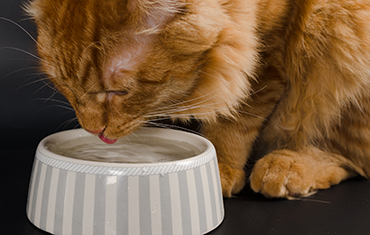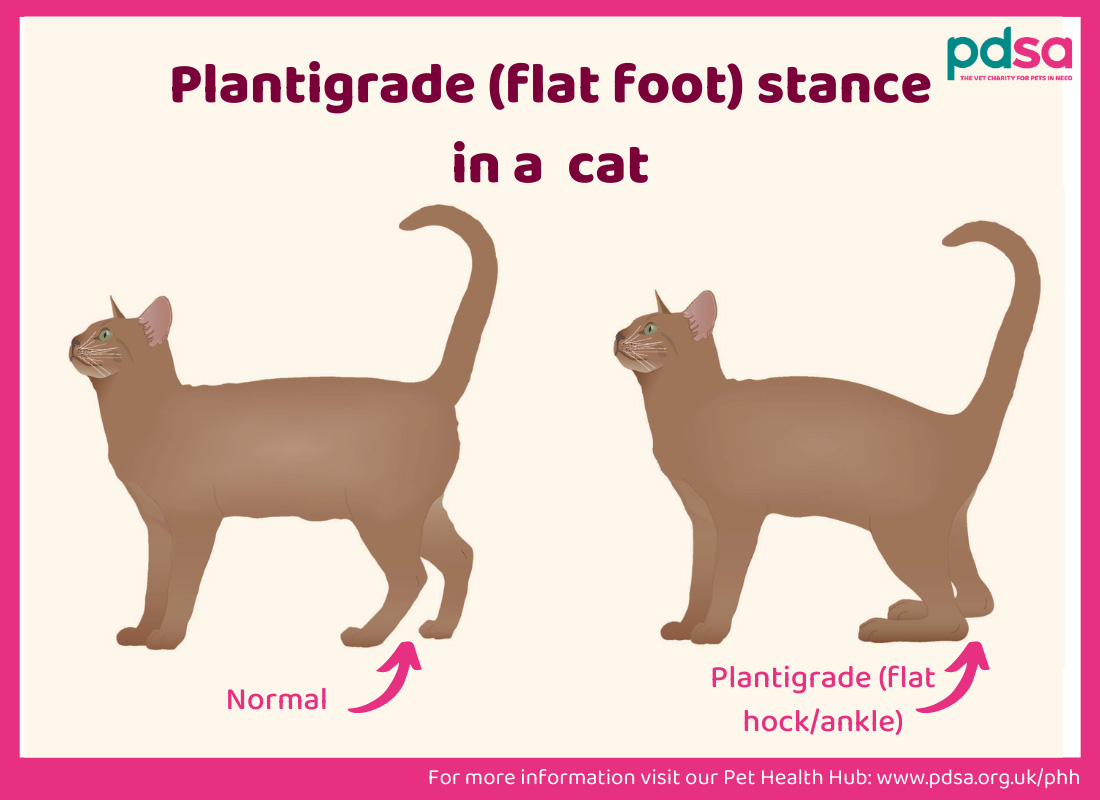Diabetes in cats
Overview
- Diabetes prevents your cat being able to control their blood sugar levels. Blood sugars levels get very high, and at the same time their body becomes starved of energy.
- Symptoms include drinking and peeing more.
- Diabetes is diagnosed with blood and urine tests and is treated with insulin injections and diet control.
- Most cats develop type 2 diabetes, unlike dogs, who usually develop type 1.
Diabetes in cats explained
Diabetes happens when there isn’t enough insulin made in the body, when the body is not responding to it correctly, or can be a combination of both. Insulin is needed to keep blood sugar levels normal and allow the body to use blood sugar (glucose) as energy.
Most cats get a form of diabetes similar to type-2 diabetes in humans, where insulin is still made by the pancreas. But for some reason, cells in the body stop responding to it, meaning the pancreas has to produce more and more insulin. Over time, the pancreas becomes exhausted and insulin production stops. Cells around the body don’t get enough energy, blood sugar levels rise abnormally high and the symptoms of diabetes develop.
Humans with type-2 diabetes don’t always need insulin injections, however cats are different. Most cats will need both insulin injections and a carefully controlled diet to manage the condition. These injections replace the insulin the pancreas was working hard to produce, making sure that sugar gets into cells where it’s needed, allowing the pancreas to rest and recover. As the blood sugar reduces, some cats can go into remission and no longer need insulin injections.
The following factors can mean your cat is more likely to develop diabetes:
- Being obese, more commonly seen in indoor cats
- Having other diseases for example pancreatitis, acromegaly, urinary tract infections and hyperthyroidism
- Being on certain medicines (usually long term and higher doses) for example steroids
- Being a middle aged or older cat
- There is also an increased risk in some breeds for example Burmese and Norwegian Forest Cats
Symptoms
Diabetic cats tend to show the following symptoms:
- Weight loss - cats with diabetes have often been overweight then very suddenly lose weight
- Drinking more
- Peeing more
- Increased appetite
- Fur changes – untidy looking coat
- Plantigrade stance (a rare symptom) – where nerve damage occurs in the hind legs, causing the hocks (heels/ankles) to drop and touch the ground (see image – click to enlarge).
If your cat is developing ‘Diabetic Ketoacidosis/DKA’, a life threatening complication of diabetes, they may show the following symptoms:
- Reduced appetite
- Weakness and low energy (lethargy)
- Collapse
- Vomiting

Cats with diabetes tend to become very thirsty

Diagnosis
History and examination
Your vet will examine your cat and ask about their symptoms. There are other illnesses, such as hyperthyroidism that can cause similar symptoms to diabetes, so further tests will be needed to confirm what’s wrong.
Blood tests
- Your vet will take a blood sample to check your cat’s blood sugar level. If your cat has diabetes, their blood sugar will be high.
- However, high blood sugar can also be caused by stress (especially when visiting the vets) so to be sure of a diagnosis, your vet may want to repeat the test on a different day - potentially after a short period of fasting.
- It’s likely that your vet will also need to run some extra blood tests to rule out other problems.
Urine tests
- Your vet will also check whether your cat’s urine contains sugar (glucose).
- It might be helpful to bring a urine sample to your appointment. Watch our video below to learn more.
 Video found at youtu.be/rZmoiLXfDNY
Video found at youtu.be/rZmoiLXfDNY
Treatment
Treating your cat’s diabetes will involve two main things, diet/weight control and insulin injections. The aim of treatment is to keep your cat’s blood sugar levels steady, and their symptoms under control. Some cats even go into remission, meaning they don’t need insulin injections anymore, this is discussed more below.
1. Diet control
What your diabetic cat eats is a very important part of their treatment.
- Give high protein, low carbohydrate: The best food for diabetic cats is a high protein, low carbohydrate, wet food. There are also commercial foods made specifically for diabetic cats. Your vet will be able to advise you which is best for your cat.
- Feed little and often: It’s best to mimic your cat’s natural eating pattern and feed them regular, small meals throughout the day.
- Portion control: It’s essential to control your cat’s portions so they don’t become overweight. If your cat is already overweight, you will need to feed them less calories so they lose weight. Keeping your cat slim and active will make their diabetes much easier to control.
- Be consistent: Give your cat the same amount and the same type of food each day, don’t be tempted to add any extra treats in.
2. Insulin injections
Insulin injections are vitally important for controlling your cat’s blood sugar levels.
- You will usually need to inject your cat with insulin twice a day.
- Your vet will carefully work out how much insulin your cat needs and show you how to inject. It’s important to be accurate about how much insulin you give because:
- too much can cause dangerously low blood sugar (hypoglycaemia)
- too little will mean their blood sugar stays high.
- It’s important to give your cat their injections at roughly the same times each day, but they can be within a two hour window either side of their normal injection time. For example, if you usually give your cat their injections at 8am and 8pm, anytime between 6am-10am and 6pm-10pm is fine.
- If you make a treatment mistake, such as missing a dose, accidentally giving too much/too little or if you aren’t sure whether your cat has had the correct amount, don’t panic. Just contact your vet for advice.
- If your cat vomits or refuses to eat through the day, speak to your vet before giving them insulin.
Have a look at our video on how to inject your diabetic dog with insulin below, as the technique is the same for dogs and cats.
 Video found at youtu.be/3RGvQz_X29A
Video found at youtu.be/3RGvQz_X29A
Remission
It’s possible for some cats to go into remission from diabetes. This means that they start producing their own insulin again, and are able to control their blood sugars without injections. Not all cats can achieve remission.
Diabetic ketoacidosis
If your cat’s diabetes isn’t controlled, they may develop a condition called ‘diabetic ketoacidosis/DKA’. If your cat develops ketoacidosis, they will become very poorly and it’s likely that they will need admitting to the veterinary hospital.
Your vet will give them intensive treatment including fluids and medications until they are well enough to come home. Ketoacidosis is a serious condition that often takes several days to recover from, and can lead to death if it’s not treated quickly.
Low blood sugar (hypoglycaemia)
Your cat might develop low blood sugar if they have been vomiting, had too much insulin, not enough food, or if they are going into remission. Signs of low blood sugar include:
- Becoming weak and wobbly
- Lethargy (low energy)
- Vomiting
- Twitching and seizures
- Collapse
Low blood sugar is an emergency and can be fatal if left untreated. If you suspect your cat is developing low blood sugar, offer them some food straight away. If they won’t eat, rub something sugary into their gums such as a sugary glucose based gel, honey or sugar water. Contact your vet immediately for an emergency appointment.
Monitoring
Regular check-ups
Your cat will need regular check-ups so that your vet can ensure their diabetes is stable. This will include being examined and weighed at each appointment. They are also likely to need regular blood tests, especially in the first few weeks after being diagnosed.
At home monitoring
The most important monitoring you can do at home is keeping track of the signs your cat is showing. Keep a diary of your cat’s appetite, behaviour, drinking and peeing. It’s also important to keep a note of your cat’s weight – check out our video how to weigh your cat at home .
Blood sugar (glucose) tests
Your cat’s blood sugar (glucose) levels will vary throughout the day. So your vet may suggest checking them at regular intervals over one day, which is called a glucose curve.
While this can be done at your vet practice, most cats find vet visits very stressful which affects the results. With patience and training, it may be possible for you to monitor their blood sugar (glucose) at home. This can be done in two ways:
- Glucometer - a blood glucose monitor that uses a tiny drop of blood from the ear or the footpad.
- CGM (continuous glucose monitoring) - a sensor stuck to the skin linked to a handheld reader or smartphone to read results. This stays in place for up to two weeks so readings can be taken constantly without the need to use a needle.
Not every cat will allow their owners to track their glucose, but with training and time, many will tolerate it. Always have an open discussion with your vet about what you feel comfortable doing at home. Any measurements taken at home should always be discussed with your vet to guide any treatment changes.
Outlook
The outlook for diabetic cats is variable. It can be good if they are treated quickly, respond well and have no other illnesses that complicate treatment. Some cats need to stay on insulin for the rest of their lives but some can go into remission, meaning they no longer need insulin injections and can be managed with food alone.
Cats that do achieve remission frequently develop diabetes again in the future, so they must be monitored closely and kept on a controlled diet.
However, there is a worse outlook for cats that have other illnesses alongside diabetes, which can make treatment much more difficult. If your cat has a complicated case of diabetes and it’s causing them to suffer, it may be necessary to consider the difficult decision of putting them to sleep.
If your cat’s diabetes is left untreated, it will cause suffering, severe illness and eventually be fatal.
Prevention
Not all cases of diabetes can be prevented, but you can reduce your cat’s chances of developing the condition by feeding them a good quality diet, keeping them slim and encouraging them to stay active.
When to contact your vet
Contact your vet for an appointment if your cat is showing any of the symptoms listed above or you are worried they might have diabetes.
The sooner your cat is diagnosed and treated, the easier the condition is to manage and the better their chance of recovery.
You know your cat best, always contact your vet if you’re concerned.
Costs and practicalities
If your cat has been diagnosed with diabetes and you’re concerned about the cost and practicalities of looking after them, don’t worry, you’re not alone. Your vet practice will give you plenty of support.
Treating a diabetic cat requires teamwork between you and your veterinary practice – they will always be on the end of the phone to give you advice, support and arrange regular check-ups for your cat.
For some owners, the commitment or cost of caring for a diabetic cat is too much. It’s very important to speak openly to your vet about what you think is right for your cat, your lifestyle, finances, and how you think you’ll cope.
Treating a diabetic cat can become very expensive. Consider insuring your cat as soon as you get them, before any signs of illness start, to ensure you have financial support to care for them.
- What happens if my diabetic cat isn’t treated?
- What long term complications might happen?
- What happens if I miss a dose or give the wrong dose of insulin?
- What happens if my cat has gone wandering when they are due insulin?
- Will the injections hurt my cat?
- What happens if I need to change my routine?
- How important is it that my cat has a diabetic diet?
- Will my diabetic cat need to lose weight?
- Why do some cats go into remission?
What happens if my diabetic cat isn’t treated?
If you leave your cat’s diabetes untreated, it will cause suffering, severe illness and eventually be fatal.
What long term complications might happen?
Long-term complications of high blood sugar can include diabetic neuropathy where cats have a plantigrade stance for example walking with dropped hind legs (see picture above). This is reversible if diabetes is diagnosed early enough. Cats can also develop cataracts but this is much rarer than in dogs.
What happens if I miss a dose or give the wrong dose of insulin?
If you miss a dose, give the wrong amount or are unsure how much insulin your cat has been given, always contact your vet for advice straight away.
What happens if my cat has gone wandering when they are due insulin?
If this happens, try not to panic, your cat can have their injection up to two hours later than scheduled. However, if it’s any later, contact your vet for advice on when to give the next dose. To avoid this happening, it is best to try to get your cat into a routine of when they will have their food and injections, so they know when to come home.
Will the injections hurt my cat?
Cats usually tolerate injections surprisingly well, due to the tiny size of the insulin needles. They may feel a small pinch but most cats don’t react at all.
What happens if I need to change my routine?
It’s possible to change your routine and the timings of your cat’s insulin injection if needed. Speak to your vet about staggering the times gradually each day until you are in your new routine.
While it’s important to be as consistent as possible with timings, a variation of one to two hours around when your cat is due their injection is acceptable. Trying to achieve ‘perfect’ management of diabetes should never be at the expense of you or your cat’s quality of life and schedules can be adapted to make them more manageable.
How important is it that my cat has a diabetic diet?
Feeding the right food can make managing your cat’s diabetes much easier, and can even increase the chance of your cat going into remission. However, the most important thing is that your cat will eat whatever diet you chose, particularly as cats diagnosed with diabetes can sometimes go off their food. Studies have shown that cats are more likely to go into remission if they are fed low carbohydrate, high protein diet.
Will my diabetic cat need to lose weight?
For cats that have been diagnosed with diabetes and are obese, weight loss can be an important part of managing diabetes and may help your cat achieve remission. Work closely with your vet, slow and steady weight loss is the aim.
Why do some cats go into remission?
Remission can happen if the pancreas is able to start insulin production again. It’s more likely in cats who were obese and have successfully lost weight, cats that were previously treated with drugs that caused diabetes that have subsequently been stopped and cats that have had their blood sugar (glucose) brought under control quickly. Cats on a diabetic diet are also more likely to go into remission.
Published: March 2024
Did you find this page useful?
Tell us more
Please note, our vets and nurses are unable to respond to questions via this form. If you are concerned about your pet’s health, please contact your vet directly.
Thank you for your feedback
Want to hear more about PDSA and get pet care tips from our vet experts?
Sign up to our e-newsletter
Written by vets and vet nurses. This advice is for UK pets only. Illustrations by Samantha Elmhurst.
